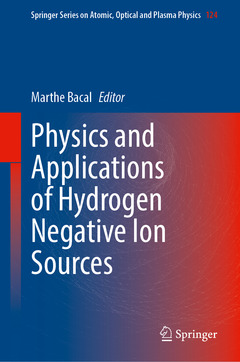Description
Physics and Applications of Hydrogen Negative Ion Sources, 1st ed. 2023
Springer Series on Atomic, Optical, and Plasma Physics Series, Vol. 124
Coordinator: Bacal Marthe
Language: English
Subject for Physics and Applications of Hydrogen Negative Ion Sources:
617 p. · 15.5x23.5 cm · Hardback
Description
/li>Contents
/li>Biography
/li>Comment
/li>
1. Marthe Bacal, Isotope effect in negative hydrogen ion volume sources
2. Motoi Wada, Fundamental aspect of surface production of hydrogen negative ions
3. Iztok Čadež and Sabina Markelj, Dissociative electron attachment to hydrogen and its use for vibrational spectroscopy of hydrogen molecule
4. Ivo Furno, Helicon volume source for H- and D- using a resonant birdcage antenna on RAID
5. Mamiko Sasao, Plasma electrode for Caesium-free negative hydrogen ion sources
6. H. Horiike, Low temperature high density ion source plasma
7. F. Taccogna, G. Fubiani, P. Minelli, Particle-In-Cell Modeling of Negative Ion Sources for fusion applications
8. Wei Yang, Modeling of reaction dynamics in volume-production negative hydrogen ion sources
9. Yuri Belchenko, Physics of surface-plasma H- ion sources
10. Christian Wimmer, Insights in physics of surface produced negative hydrogen ions by diagnostics
11. Ursel Fantz, RF Driven ion sources for Fusion NBI
12. Dan Faircloth, Negative ion source technology
13. Stéphane Béchu, Panagiotis Svarnas, Fundamental principles of ECR-driven negative ion sources operating with hydrogen and deuterium
14. Martin Stockli, Baoxi Han, RF H- sources
15. Martin Stockli, Sarah Cousineau, Acceleration of the H- beams in SNS
Features up-to-date and comprehensive coverage of hydrogen negatives sources
Provides a complete physical description of the operation of both volume and surface negative ion sources
Describes hydrogen negative ion sources for fusion and accelerator applications



